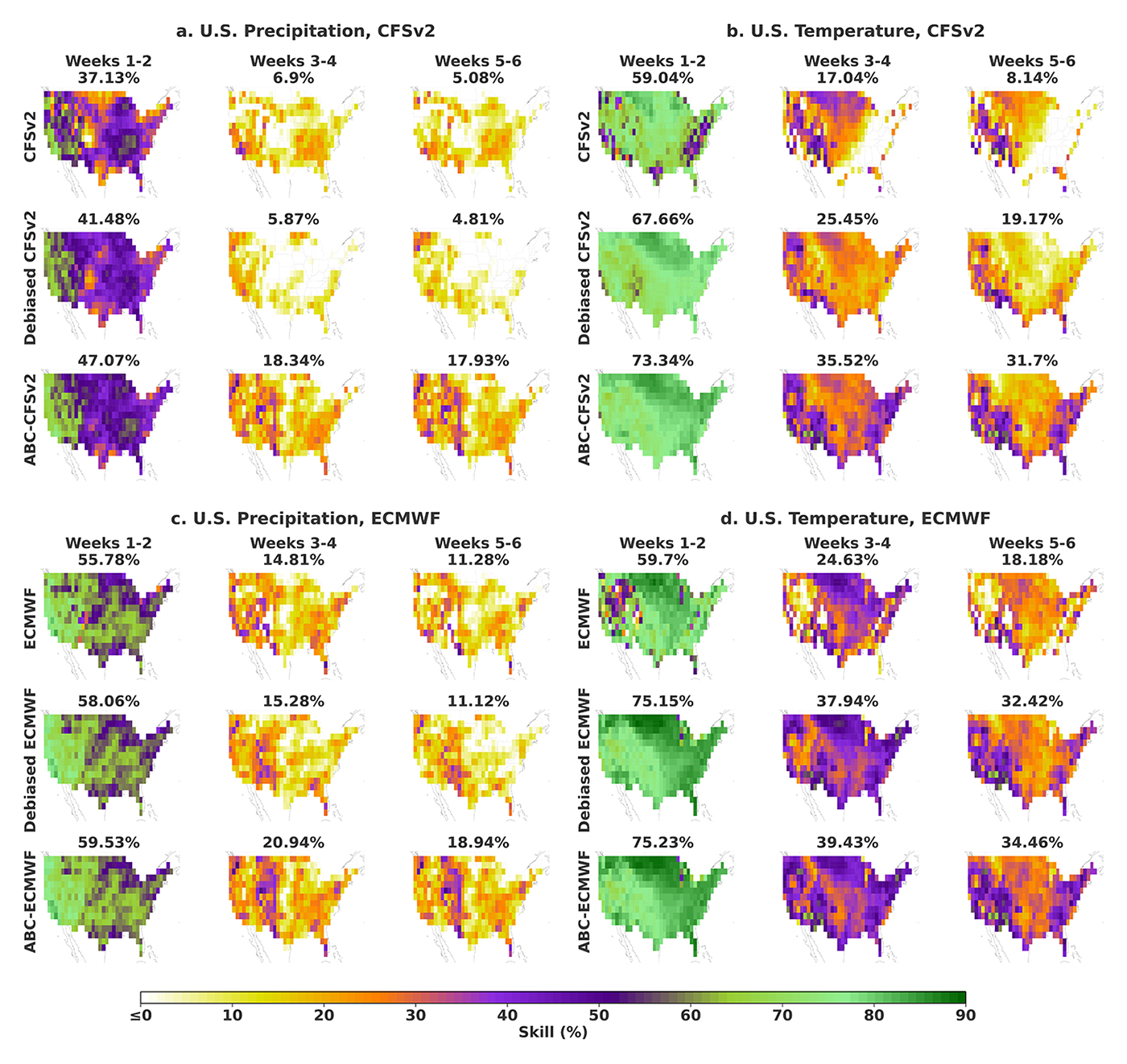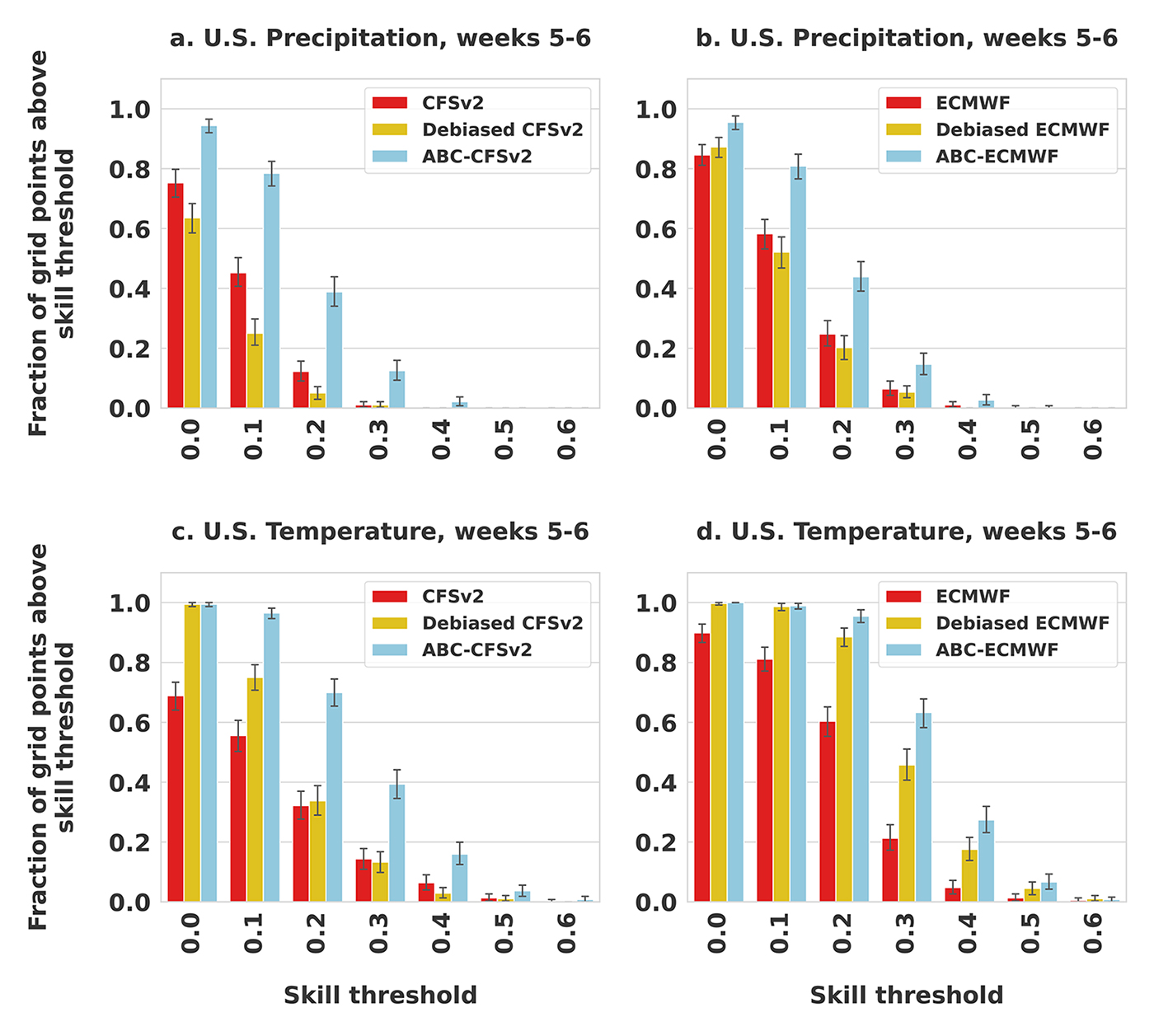This content was previously published by Nature Portfolio and Springer Nature Communities on Nature Portfolio Earth and Environment Community.
Improving our ability to forecast the weather and climate is of interest to all sectors of the economy and to government agencies from the local to the national level. Weather forecasts zero to ten days ahead and climate forecasts seasons to decades ahead are currently used operationally in decision-making, and the accuracy and reliability of these forecasts has improved consistently in recent decades (Troccoli, 2010). However, many critical applications – including water allocation, wildfire management, and drought and flood mitigation – require subseasonal forecasts with lead times in between these two extremes (Merryfield et al., 2020; White et al., 2017).
While short-term forecasting accuracy is largely sustained by physics-based dynamical models, these deterministic methods have limited subseasonal accuracy due to chaos (Lorenz, 1963). Indeed, subseasonal forecasting has long been considered a “predictability desert” due to its complex dependence on both local weather and global climate variables (Vitart et al., 2012). Recent studies, however, have highlighted important sources of predictability on subseasonal timescales, and the focus of several recent large-scale research efforts has been to advance the subseasonal capabilities of operational physics-based models (Vitart et al., 2017; Pegion et al., 2019; Lang et al., 2020). Our team has undertaken a parallel effort to demonstrate the value of machine learning methods in improving subseasonal forecasting.
The Subseasonal Climate Forecast Rodeo
To improve the accuracy of subseasonal forecasts, the U.S. Bureau of Reclamation (USBR) and the National Oceanic and Atmospheric Administration (NOAA) launched the Subseasonal Climate Forecast Rodeo, a yearlong real-time forecasting challenge in which participants aimed to skillfully predict temperature and precipitation in the western U.S. two-to-four weeks and four-to-six weeks in advance. Our team developed a machine learning approach to the Rodeo and a SubseasonalRodeo dataset for training and evaluating subseasonal forecasting systems.

Spotlight: On-Demand EVENT
Microsoft Research Summit 2022
On-Demand
Watch now to learn about some of the most pressing questions facing our research community and listen in on conversations with 120+ researchers around how to ensure new technologies have the broadest possible benefit for humanity.
Our final Rodeo solution was an ensemble of two nonlinear regression models. The first integrates a diverse collection of meteorological measurements and dynamic model forecasts and prunes irrelevant predictors using a customized multitask model selection procedure. The second uses only historical measurements of the target variable (temperature or precipitation) and introduces multitask nearest neighbor features into a weighted local linear regression. Each model alone outperforms the debiased operational U.S. Climate Forecasting System version 2 (CFSv2), and, over 2011-2018, an ensemble of our regression models and debiased CFSv2 improves debiased CFSv2 skill by 40%-50% for temperature and 129%-169% for precipitation. See our write-up Improving Subseasonal Forecasting in the Western U.S. with Machine Learning for more details. While this work demonstrated the promise of machine learning models for subseasonal forecasting, it also highlighted the complementary strengths of physics- and learning-based approaches and the opportunity to combine those strengths to improve forecasting skill.
Adaptive Bias Correction (ABC)
To harness the complementary strengths of physics- and learning-based models, we next developed a hybrid dynamical-learning framework for improved subseasonal forecasting. In particular, we learn to adaptively correct the biases of dynamical models and apply our novel adaptive bias correction (ABC) to improve the skill of subseasonal temperature and precipitation forecasts.

ABC is an ensemble of three new low-cost, high-accuracy machine learning models: Dynamical++, Climatology++, and Persistence++. Each model trains only on past temperature, precipitation, and forecast data and outputs corrections for future forecasts tailored to the site, target date, and dynamical model. Dynamical++ and Climatology++ learn site- and date-specific offsets for dynamical and climatological forecasts by minimizing forecasting error over adaptively-selected training periods. Persistence++ additionally accounts for recent weather trends by combining lagged observations, dynamical forecasts, and climatology to minimize historical forecasting error for each site.
ABC can be applied operationally as a computationally inexpensive enhancement to any dynamical model forecast, and we use this property to substantially reduce the forecasting errors of eight operational dynamical models, including the state-of-the-art ECMWF model.

A practical implication of these improvements for downstream decision-makers is an expanded geographic range for actionable skill, defined here as spatial skill above a given sufficiency threshold. For example, we vary the weeks 5-6 sufficiency threshold from 0 to 0.6 and find that ABC consistently boosts the number of locales with actionable skill over both raw and operationally-debiased CFSv2 and ECMWF.

We couple these performance improvements with a practical workflow for explaining ABC skill gains using Cohort Shapley (Mase et al., 2019) and identifying higher-skill windows of opportunity (Mariotti et al., 2020) based on relevant climate variables.

To facilitate future deployment and development, we also release our model and workflow code through the subseasonal_toolkit Python package.
The SubseasonalClimateUSA dataset
To train and evaluate our contiguous US models, we developed a SubseasonalClimateUSA dataset housing a diverse collection of ground-truth measurements and model forecasts relevant to subseasonal timescales. The SubseasonalClimateUSA dataset is updated regularly and publicly accessible via the subseasonal_data package. In SubseasonalClimateUSA: A Dataset for Subseasonal Forecasting and Benchmarking, we used this dataset to benchmark ABC against operational dynamical models and seven state-of-the-art deep learning and machine learning methods from the literature. For each subseasonal forecasting task, ABC and its component models provided the best performance.

Online learning with optimism and delay
To provide more flexible and adaptive model ensembling in the operational setting of real-time climate and weather forecasting, we developed three new optimistic online learning algorithms — AdaHedgeD, DORM, and DORM+ — that require no parameter tuning and have optimal regret guarantees under delayed feedback.

Our open-source Python implementation, available via the PoolD library, provides simple strategies for combining the forecasts of different subseasonal forecasting models, adapting the weights of each model based on real-time performance. See our write-up Online Learning with Optimism and Delay for more details.
Looking forward
We’re excited to continue exploring machine learning applied to subseasonal forecasting on a global scale, and we hope that our open-source packages will facilitate future subseasonal development and benchmarking. If you have ideas for model or dataset development, please contribute to our open-source Python code or contact us!
The post Improving Subseasonal Forecasting with Machine Learning appeared first on Microsoft Research.

